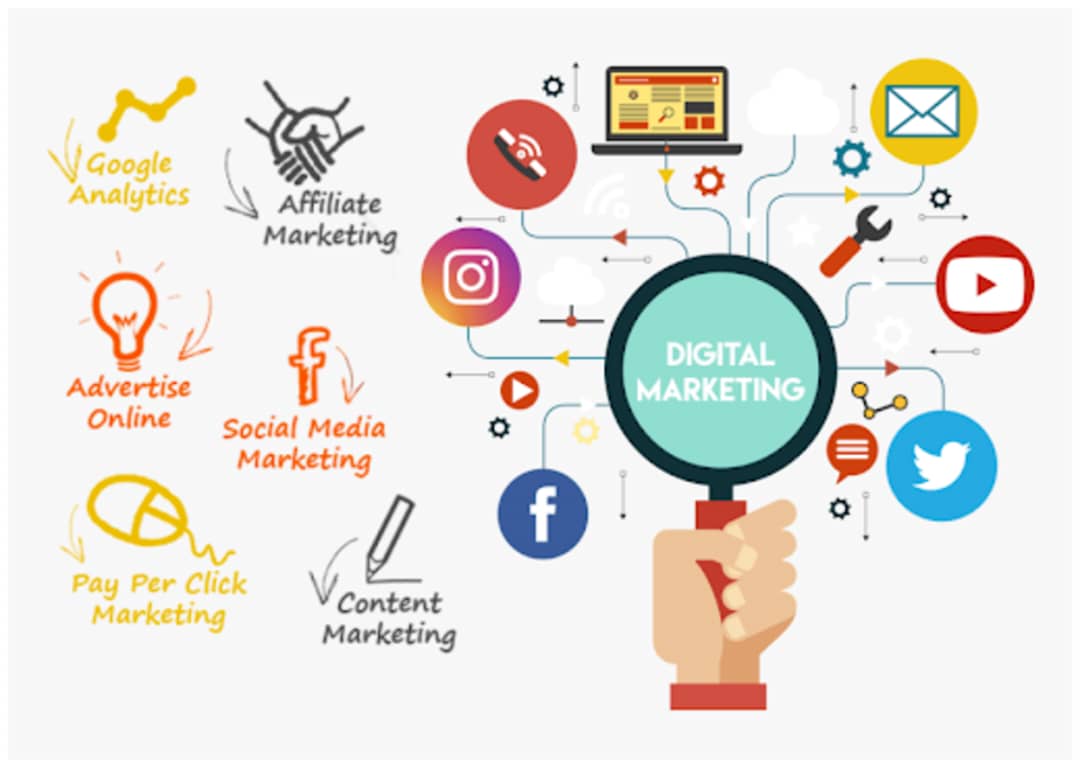Marketing is an essential part of a successful business. In today’s world, there are two main types of marketing: digital marketing and conventional marketing. Digital marketing is the use of digital channels such as: social networks, email and search engines to promote products or services. Conventional marketing, on the other hand, includes methods such as: TV ads, print ads, and billboards. It can be difficult for business owners to determine which marketing approach is best for their business. In this blog post, we will explore the pros and cons of digital and conventional marketing, and we’ll help you choose the best approach for your business needs. Let’s dive in!
Understand digital marketing
The advantage of digital or digital marketing is that it has gained momentum in recent years. Therefore, it is important for companies to understand how digital communication works. Digital marketing is the process of promoting a product or service using digital channels such as: social media, email marketing, search engine optimization and online advertising .
The main advantage of digital marketing is that it allows businesses to reach large audiences quickly and easily. With the increasing use of the internet and the rise of social media, businesses can now target specific demographic groups with their marketing efforts. This targeted approach can lead to better results and a better return on investment.
Another advantage of digital marketing is that it is more cost effective than traditional marketing methods. Thanks to a digital marketing strategy, companies can run campaigns at a lower cost than traditional advertising methods such as: television, radio or print media. Additionally, digital marketing allows for more accurate tracking and analysis of a campaign’s effectiveness. This means businesses can adjust their marketing efforts as needed, resulting in better results over time. All in all, digital marketing can be a great way for businesses to reach their target audience and promote their products or services profitably.
Understanding Conventional Marketing
Conventional marketing, also called traditional marketing, refers to any type of marketing that has been used for a long time. This includes advertising in newspapers, magazines, radio and television. Classic marketing also involves direct mail, billboards and telemarketing. Conventional marketing can also include word of mouth marketing and networking. These marketing methods have been around for years and are used successfully by businesses of all sizes.
They can be effective and relevant in reaching large audiences and creating brand awareness. However, conventional marketing can be quite expensive and the return on investment can be difficult to measure. Additionally, it can be difficult to target specific audiences or prospects with conventional marketing, as well as track the effectiveness of your marketing efforts. Despite these challenges, conventional marketing can still be an effective way to reach new customers and promote your business if used correctly.
Pros and Cons of digital marketing
Digital marketing has become increasingly popular in recent years due to its ability to reach a wider audience at a much lower cost. However, like any real marketing strategy, digital marketing has its pros and cons.
Pros of digital marketing
One of the most important benefits of digital marketing is that it allows businesses to reach large audiences at a lower cost. With digital marketing, you can target specific audiences based on demographics, interests, and behavior. This means you can implement a strategy of personalized marketing messages, which are more likely to resonate with your target audience.
Another benefit of digital marketing is that it provides community management with measurable results through Google Analytics. You can follow the success of your campaigns or marketing actions in real time and make the necessary changes. This allows you to optimize your campaigns for better results. However, digital marketing also has drawbacks.
Cons of digital marketing
One of the biggest challenges is the constant evolution of technology. With new platforms and marketing tools constantly emerging, it can be difficult to keep up with the latest trends and best practices. In addition, digital marketing requires a high level of technical expertise and innovative digital media. Which can be daunting for business owners who are unfamiliar with technology.
Finally, digital marketing or web communication can be impersonal. Unlike traditional marketing methods such as: face-to-face interactions or direct mail, digital marketing relies on technology and digital levers to communicate with customers. This can make it difficult to build trust, build rapport with your target audience, and reduce conversion rate.
Pros and Cons of conventional marketing
Conventional marketing has been around for decades, but with the rise of digital marketing, many businesses are beginning to question whether it’s still the best approach. Conventional marketing has both advantages and disadvantages, and it’s important to understand both aspects before deciding which approach is right for your business branding.
Benefits of Conventional Marketing
tangible presence
Classic marketing channels such as billboards, flyers, and TV ads provide a tangible presence that can be seen and felt by customers.
A wider reach
Traditional marketing channels can reach a wider audience than digital marketing, especially when targeting older generations who may not be as tech-savvy or internet-marketing savvy.
Personal interaction
Traditional marketing channels can enable good customer relations and personal interactions with customers, for example at a trade show or in-store promotions.
Cons of conventional marketing
High cost
Traditional marketing channels can be very expensive, especially for small businesses with limited budgets.
Difficult to track return on investment
It can be difficult to measure the return on investment (ROI) of traditional marketing campaigns because it’s hard to know how many people saw a billboard and then made a purchase.
Limited targeting
Traditional marketing channels are less targeted than digital marketing channels because you can’t choose who sees your billboard or who receives your flyer. Overall, conventional marketing can still be effective for some businesses, but it’s important to consider the high costs and limited targeting to be successful with your strategy. Digital marketing may be best suited for businesses with limited budgets or those looking for a more targeted approach.
Which approach is best for your business?
When it comes to marketing, choosing the right approach for your business is crucial. In today’s world, digital marketing is increasingly popular due to its wide reach and cost effectiveness. With effective marketing techniques, you can reach a larger audience in less time and at a lower cost compared to conventional marketing methods.
In addition, digital marketing offers the flexibility to adapt your digital marketing and communication plan to your audience or target group. This makes it easy to track and evaluate the effectiveness of your content marketing strategy . However, classic marketing methods such as: print, radio and television advertising still have their own advantages. They can be more effective at reaching local audiences or creating brand awareness in specific communities.
They also provide a more tangible experience for your audience, allowing them to feel and see your product or service in person. Ultimately, the best approach for your business will depend on your target audience, budget, and goals. It may even require a combination of digital and conventional marketing methods for optimal results.
Conclusion
After weighing the pros and cons of digital marketing and conventional marketing, it’s clear that digital marketing has the upper hand in today’s world. The ability to target specific audiences through social media platforms, b2b emailing and search engine optimization allows for a more personalized approach to marketing. Additionally, the ability to track and analyze data provides valuable insight into the success of campaigns and enables real-time adjustments.
However, it’s important not to completely neglect classic marketing techniques like print, billboard, and TV ads, as they still have value in certain industries and demographics. Ultimately, the best approach is to combine digital and conventional marketing techniques tailored to the specific needs of a marketing company or agency and its target audience.
What is Digital Marketing?
What are the advantages of digital marketing over traditional marketing?
How Does Search Marketing (SEM) Work?
What is Social Media Marketing?
How does email marketing work?
How to measure the effectiveness of digital marketing?











